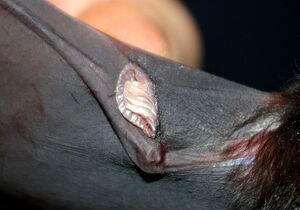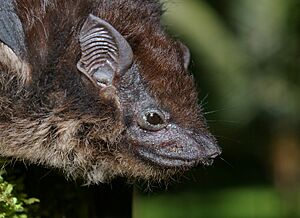Greater sac-winged bat facts for kids
Quick facts for kids Greater sac-winged bat |
|
|---|---|
 |
|
| Conservation status | |
| Scientific classification | |
| Genus: |
Saccopteryx
|
| Species: |
bilineata
|
 |
|
| Greater sac-winged bat range | |
The greater sac-winged bat (Saccopteryx bilineata) is a cool bat that lives in Central and South America. It belongs to a bat family called Emballonuridae.
These bats are often seen in rainforests. They like to rest on the outside of big trees. They are insectivores, meaning they eat insects. They use special sounds called echolocation to find their food. Their diet includes flies, beetles, butterflies, and moths. Their nose and upper lip can move a lot to help them open their mouth wide.
About the Greater Sac-winged Bat
The greater sac-winged bat is known for its unique wing sacs. These are small pouches found on their wings. Male bats use these sacs for two main reasons. They help males attract female bats. They also help males mark their territory.
How Wing Sacs Work
Every day, male bats clean themselves. During this time, they fill their wing sacs. They use drops of their urine and special liquids from their glands.
When a male wants to impress a female, he hovers in front of her. He flaps his wings fast to fan the air towards her. This spreads the scent from his wing sacs. The smell helps him show off to the female.
Males also use these sacs to warn other bats. If a bat from outside his group comes too close, the male will shake the sac contents at them. This tells intruders to stay away. Scientists think tiny living things inside the sac might help create these special smells.
Bat Babbling
Young sac-winged bats, called pups, make many different sounds. Sometimes, these sounds are mixed up. For example, a female pup might make a sound usually used by males for courting. Then, she might make echolocation clicks. After that, she could make sounds that adult bats use to protect their territory.
This mixed-up way of making sounds is like how human babies babble. It's also similar to how young birds try to sing before they learn their full song. This is one of the first times scientists have seen this "babbling" behavior in a mammal that isn't a primate.




